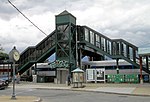Camp Smith (New York)
Camp Smith is a military installation of the New York Army National Guard in Cortlandt Manor near Peekskill, NY, about 30 miles (48 km) north of New York City, at the northern border of Westchester County, and consists of 1,900 acres (7.7 km2). Established in 1882 by General Frederick Townsend, Adjutant General of New York, it was formerly known as "Camp Townsend", but was renamed in 1919 to "Camp Smith" for Governor Alfred E. Smith of New York.The camp has been used as an annual training site for National and State Guard regiments since its establishment, and recently has served as the home of the Empire State Military Academy, as well as the state's Non-Com, Officer Candidate School, and a Westchester County DES satellite fire training center. It also hosts some other units (e.g. The Headquarters and Headquarters Detachment of the 53rd Troop Command, 42nd Infantry Division Band, 138th Chaplain Support Team).
Excerpt from the Wikipedia article Camp Smith (New York) (License: CC BY-SA 3.0, Authors).Camp Smith (New York)
Camp Smith Drive,
Geographical coordinates (GPS) Address Nearby Places Show on map
Geographical coordinates (GPS)
| Latitude | Longitude |
|---|---|
| N 41.298888888889 ° | E -73.941944444444 ° |
Address
Camp Smith Drive 9
10567
New York, United States
Open on Google Maps






